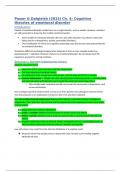Samenvatting
Summary for interim exam 1 of Mood, Anxiety & Psychotic Disorders
This is a long, extensive summary of the reading material and lectures for interim exam 1 of the course Mood, Anxiety & Psychotic Disorders at the Universiteit van Amsterdam. It includes summaries of all the reading materials for interim exam 1 in the academic year 2023/2024, and includes notes and...
[Meer zien]













